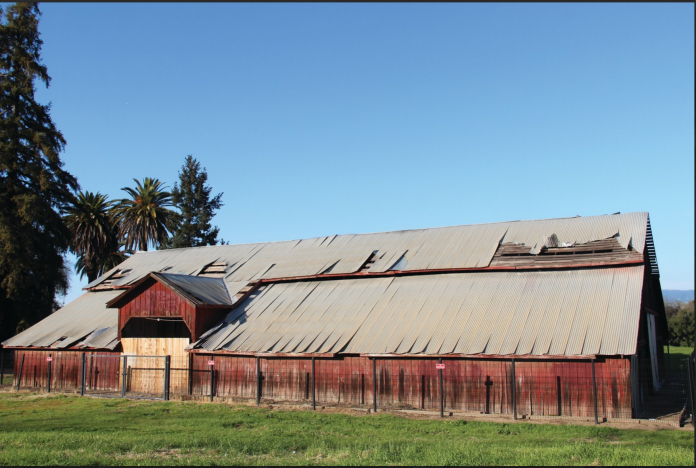“It is so exciting that we can finally see the light at the end of the tunnel,” said Kathy Chavez, a local resident who has been working for more than two years to save the historic red barn in Christmas Hill Park from demolition.
Chavez and others believe the structure was built by cattle rancher Henry Miller, at one time the largest landowner in the West, to store and process fruit in 1891.
The city-owned barn, used most recently as a storage space for the Gilroy Garlic Festival, was slated for demolition in 2013 after two separate studies found the outbuilding had no historical value.
That was when Chavez and other local history buffs requested and received a last-minute reprieve from the city, which delayed the demolition.
Over the next two years a group of volunteers spent hundreds of hours poring over newspaper clippings, deeds and other official documents looking for anything that linked Henry Miller to the building, which is now home to bats and other vermin.
Chavez said the activist-historians would sift through archives that had never been catalogued or put on microfiche.
“No building permits or deeds were ever found,” she said, adding that it was not unusual for outbuildings to lack such permits at that time. But, one day, the Eureka moment finally came.
Under the simple heading, “Gilroy Improvements” in the Evening News, a San Jose newspaper published on May 9, 1891, the researchers finally found the proof they had been looking for:
“Henry Miller will soon commence to work on his proposed building at the Glen Farm near Gilroy. It will consist of a large barn, storehouse for dried fruit and lodging house combined.”
“He knew dirt,” said Pat Escamilla, a former Gilroy resident and expert on Henry Miller. Escamilla said Miller, who came to California from Germany in 1850 at age 23, would go over every piece of his land to determine exactly what he was going to do with it, what needed clearing and where to put in wells.
Miller bought the Glen Ranch property where the red barn now stands in the 1880s, said Escamilla. He planted throughout the property, 26 acres of various fruit trees—peaches, olives, pears, apples, apricots and then prunes, and wine grapes. Old vines went up through Christmas Hill Park; the orchard went all the way to Hanna Street.
It was not a business at first, said Escamilla. The cattleman was experimenting to see what would grow in this Mediterranean climate and it was not unusual for him to plant small orchards and gardens on his ranches to ensure his workers had fresh fruit and vegetables.
Miller was in his 50s when he entered this fruit-planting phase of his life and 64 when he built the red barn to store his growing yield.
“He was producing enough fruit and needed the space,” said Carol DeSantis, a member of the Save The Miller Red Barn Committee, who is working on an application that would place the barn on the National Register of Historic Places.
Miller used the barn to process dried fruit, DeSantis explained. Workers would lay out racks of prunes to dry in the sun and then bring them into the barn overnight. Apricots were pitted, dipped in sulfur to keep from turning before being packed and sent to distributors.
In 1906, Miller leased the Glen Ranch to the California Wine Association for a period of 15 years. DeSantis said wine production was booming on the ranch under the auspices of the association. A winery was built on the premises and Southern Pacific ran a train line directly to the plant. Miller died in 1916.
The property’s connection to the California Wine Association, which operated from 1894 to 1936, adds to the historical significance of the property, said DeSantis.
If all goes according to plan, DeSantis’ application, which she has been working on for a year and a half, will go before the state historic preservation commissioners on July 7 for a decision.
A historic designation would protect the barn from demolition and major changes, while also giving it a status for fundraising, she said.
DeSantis said it is not unusual for barns to be protected—in Washington, the famed racing horse Seabiscuit has its barn listed on the national register.
In the meantime, a memorandum of understanding between the city and the community activists who sought to save a part of Gilroy’s agricultural heritage is currently making its way through City Hall.
“It took us a little longer than anticipated,” said Chavez, “but it is so exciting to finally see the light at the end of the tunnel—it’s going to happen.”
After the city attorney reviews the details of the agreement and it is sent back to the committee, the City Council will vote on rescinding the standing demolition order.
The group has already received the go-ahead by the city to secure an environmental company to clear out the barn, which has been littered with animal waste. Once it is cleaned out, the group plans on getting an architectural engineer to conduct further tests. Chavez believes the redwood used in constructing the barn came from Miller’s sawmill in Mount Madonna.
“It is worthy of being saved,” said Chavez, who hopes the barn could become an agricultural heritage museum to showcase all the various peoples and cultures that farmed or ranched in and around Gilroy.
“This could be the jewel in the crown of the Gilroy parks system,” Chavez continued. “The start of wine tours, bicycle races, foraging trips, recreation classes and family days.”













